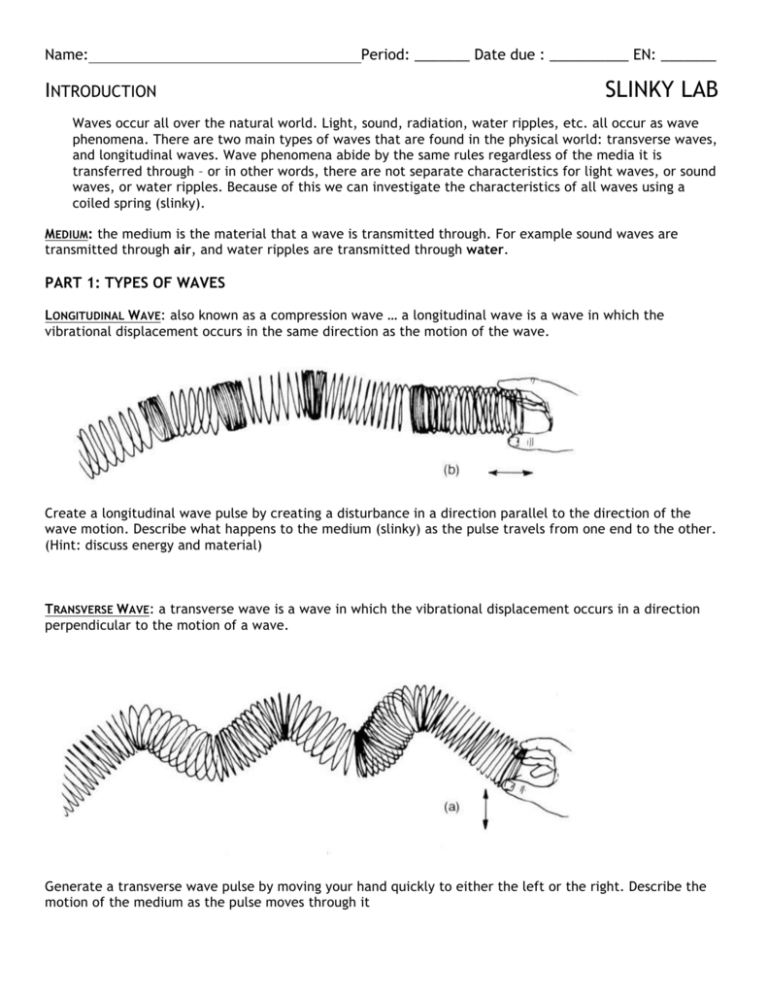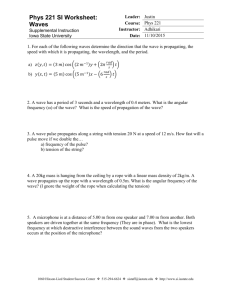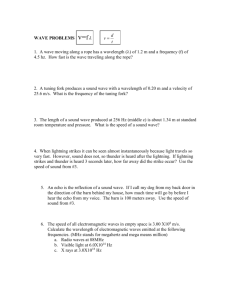Slinky Lab: Wave Characteristics Worksheet
advertisement

Name: INTRODUCTION Period: _______ Date due : __________ EN: _______ SLINKY LAB Waves occur all over the natural world. Light, sound, radiation, water ripples, etc. all occur as wave phenomena. There are two main types of waves that are found in the physical world: transverse waves, and longitudinal waves. Wave phenomena abide by the same rules regardless of the media it is transferred through – or in other words, there are not separate characteristics for light waves, or sound waves, or water ripples. Because of this we can investigate the characteristics of all waves using a coiled spring (slinky). MEDIUM: the medium is the material that a wave is transmitted through. For example sound waves are transmitted through air, and water ripples are transmitted through water. PART 1: TYPES OF WAVES LONGITUDINAL WAVE: also known as a compression wave … a longitudinal wave is a wave in which the vibrational displacement occurs in the same direction as the motion of the wave. Create a longitudinal wave pulse by creating a disturbance in a direction parallel to the direction of the wave motion. Describe what happens to the medium (slinky) as the pulse travels from one end to the other. (Hint: discuss energy and material) TRANSVERSE WAVE: a transverse wave is a wave in which the vibrational displacement occurs in a direction perpendicular to the motion of a wave. Generate a transverse wave pulse by moving your hand quickly to either the left or the right. Describe the motion of the medium as the pulse moves through it PULSE: a single disturbance in a media that moves along in a wave. WAVELENGTH: the length of a single pulse. AMPLITUDE: the maximum amount a disturbance is from a wave’s rest position. FREQUENCY: the rate at which wave pulses pass a point. PART II: WAVE CHARACTERISTICS: stretch the spring 5 meters out on the floow for the following questions. Be sure not to tangle the slinky. Use diagrams! 1. Record the time it takes to get to the other end. Repeat this several times changing the height (amplitude) of the pulse each time and recording the time from one end of the slinky to the other. How does changing the amplitude of the pulse affect how long it takes to get from one end to the other? 2. Now try generating more than one pulse. Slowly move you hand side to side at a constant rate. Describe what you see. 3. Now move you hand side to side at a faster rate and describe what you see. Include in your description what happens to the speed, frequency and size (wavelength) of the wave pulses. 4. What conclusions can you draw about how changing the amplitude and frequency of the source affects the characteristics of a wave? 5. Now change the tension in the slinky. Do this by holding the slinky not at the end but about 1 meter in. Make sure it is still stretched 5 meters however. Make a wave pulse with as close to an identical disturbance as you did above and record the time it takes to get to the other end. Repeat this again making the slinky even tighter. Describe how this changing the tension affects the characteristics of the wave (wavelength and speed). PART III. WAVE BOUNDARIES 1. Have your partner hold one end of the slinky strongly. Send a wave down to them and let it reflect back. This is a fixed end reflection because the end of the slinky is not allowed to move. What do you notice about the shape and motion of the reflected wave as compared to the incoming wave? DIAGRAM! LAB OBJECTIVE: a) to observe, investigate and calculate the basic characteristics of waves, using a coiled spring b) measure the speed and wavelength of a transverse wave c) create waves with different amplitudes Procedure: 1. Stretch the spring across the floor about 5 meters. Be sure to keep this distance unless directed. 2. One partner holds one end of the spring secure while the other partner will create a single wave pulse by shaking the other end of the rope back and forth on the ground. 3. Another partner will use a stopwatch to measure the time needed for the wave to travel from one end of the spring to the other. 4. Record the time in the data table. 5. Repeat two more times. 6. Calculate the speed of waves 1,2 and 3 in your data table by using the formula speed = distance/time. Find the average speed for the waves 1,2 and 3. 7. Create a wave with several wavelengths. You make one wavelength when your hand moves left, right and left again. Count the number of wavelengths generated in 10 seconds. Record. 8. Repeat the above only this time move your hand slower. Record. 9. Repeat the above only this time move your hand faster. Record. Analyze your data: 1. Calculate the frequency of waves 4,5 and 6 by dividing the number of wavelengths by 10 s. 2. Calculate the wavelength of waves 4,5 and 6. Use the average speed calculated earlier. DATA TABLE 1 Wave Property Measurement Wave Trial SHOW YOUR WORK V = wavelength x frequency Spring Length Wave Time Wave Speed Wavelength Count Frequency Wavelength 1 2 3 AVG 4 5 6 AVG CONCLUDE AND APPLY 1. Was the wave speed different for the three different pulses created? Why or Why not? 2. Why would you average the speeds of the three different pulses to calculate the speed of waves on your spring? 3. How did the wavelength of the waves you created depend on the frequency of the waves? MULTIPLE WAVE INTERACTION 1. With one person on each end of the slinky, have each person create one transverse wave of about the same size with a disturbance in the same direction. Describe what happens when the disturbances meet along the medium and after they meet. Sketch a picture of what you see. 2. Now have each person create a transverse wave, but this time make the disturbances in opposite directions (one right one left). Describe what happens when the disturbances meet along the medium and after they meet. Sketch a picture of what you see. 3. Which term best describes what happened in Step 1 and Step 2? Constructive or Destructive Interference. CLASS CHALLENGES: answer on the backside Longest wavelength, highest frequency, fastest speed Make a standing wave, can you make it resonate? Explain the phenomena of the Mayan Echoes in the Temple of Kukulkan at Chichen Itza in Mexico.








